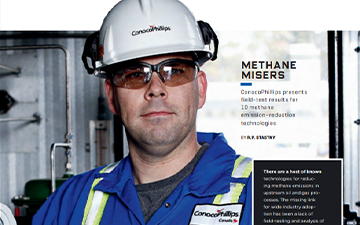CALGARY, ALBERTA - There are a host of known technologies for reducing methane emissions in upstream oil and gas processes. The missing link for wide industry adoption has been a lack of field-testing and analysis of the various technologies. So in 2010, ConocoPhillips Canada, Climate Change and Emissions Management, and the Canadian Environmental Technology Advancement Corporation-West (CETAC-WEST) took on an initiative to improve energy efficiency and reduce methane emissions across ConocoPhillips' Alberta field operations.
As part of that agreement, ConocoPhillips agreed to share its results with the wider industry, and the company did just that in December when it discussed what it had learned about the 10 technologies it tested over the last five years.
"We took this on ourselves," ConocoPhillips' president Ken Lueers told the audience of some 200 business and regulatory professionals. "It wasn't something our corporate office in Houston told us to do, it wasn't something the government told us to do. We found a way to go and enhance the economics and competitiveness of our operation through implementation of green technologies."
The ConocoPhillips team focused on fugitive emissions and vented waste of natural gas, anticipating Alberta's new policy target or reducing methane emissions by 45 per cent by 2025. Methane capture is important because, as a greenhouse gas (GHG) emission, its effect is 25 times more potent than CO2.
Sean Hiebert, ConocoPhillips' operations energy efficiency team lead, told the audience that because of the early success of the project, the company actually doubled its emission-capture expectations. In 2010, it set out to capture 50,000 tonnes/year of CO2 equivalent (CO2e) through 404 trials for an average cost of $13.80/tonne. As of mid-2015, the average cost had been mor than halved to $6.79/tonne. ConocoPhillips had also tripled the number of fiel trials to 1,214 and achieved 98,000 tonnes/year of emission cuts - the equivalent of taking 21,350 passenger cars off the road.
Winners
Of the 10 technologies tested, one was a clear winner, both for its low cost of emission capturing and the number of potential applications across ConocoPhillips' operations (and, consequently, across the industry). This technology was high-to-low bleed pneumatic controls conversion at just $2/tonne of CO2e to capture 52,000 tonnes/year of CO2e across its operations.
Spartan provided four of the technologies tested by the ConocoPhillips team: high-to-low bleed conversions, SlipStream, dehydration optimization, and REMVue (developed internally by Spartan's technology development group, REM Technology). All of these technologies made the shortlist of the economically viable and promising solutions tested by ConocoPhillips.
The other missing link
At $16/tonne, the REMVue technology seems expensive, but there's more to the story. Dowler says REMVue is actually one of the most viable emission-reducing technologies because it offers other benefits than just capturing carbon emissions.
"When this air-fuel-ratio control system is retrofitted onto a natural gas engine, one of the biggest benefits is increased performance and reliability. That increased performance and reliability translates directly into increased production, which means more dollars in the cash register," Dowler says.
In the real world of oil and gas technologies, REMVue is sold on improved reliability and production. Yes, the customer gets 15 per cent better fuel efficiency and lower emissions from tailpipe, but in the absence of CO2 legislations that apply to oilfield operations or financial incentives to help producers to make environmentally beneficial retrofits, emission capturing is a tough sell. There has to be more.
SlipStream is another Spartan innovation that offers more than just emission reductions. It targets vented emissions. (Fugitive emissions, by contrast, aren't supposed to happen. They typically occur around leaking flanges or other connections. Vented emissions are designed into some equipment as pneumatic controls of reciprocating natural gas compressors.)
Fitted on a reciprocating compressor, SlipStream captures blow-by gas from the pistons and feeds it back into the engine for combustion. The engine automatically adjusts for the addition of that fuel, thereby reducing fuel consumption.
Click here to read the full article published in OilWeek magazine.

